Category Design: How to Create and Dominate a Market Category

Sorry, there were no results found for “”
Sorry, there were no results found for “”
Sorry, there were no results found for “”

The academic roots of category design trace back to economist Paul Geroski’s 2003 book The Evolution of New Markets. It explored how entirely new market categories take shape and mature over time.
But in practice, most category creators start with confusion.
A founder often can’t describe their product without saying, ‘It’s kind of like X, but not really.’ A product manager launches something truly original, yet the audience continues to compare it to other tools. A marketer tests every possible tagline and still can’t make the message click.
Category design is necessary here, as it helps the world understand something that has never existed before. It’s part strategy, part storytelling, and part market education.
In this blog post, we’ll explore everything there is to know about making your own market category and how ClickUp, the everything app for work, supports your efforts. 🏁
Category design is a business strategy that focuses on creating and defining entirely new market categories rather than simply competing within existing ones.
Unlike traditional approaches that emphasize outdoing competitors in a crowded space, this technique aims to identify unique problems or ‘missings’ in the market. It then shapes both the narrative and the solution around this opportunity in a way that fundamentally changes how people perceive the space.
🧠 Fun Fact: The concept of category design was popularized (or sharply reintroduced) by the 2016 book Play Bigger by Christopher Lochhead. The idea: building a product + narrative + brand identity around solving a problem everyone agrees is real, so you lead a space rather than compete in one.
The best companies don’t just invent something to sell us. They are not making products or services that just incrementally improve on whatever came before. They don’t sell us better. The most exciting companies sell us different. They introduce the world to a new category of product or service—like Clarence Birdseye creating the very idea of frozen food a century ago or Uber defining on-demand transportation in recent years.
To understand what is category design in business, let’s look at the difference between product and strategy-focused strategy. 👇
| Aspect | Product-focused strategy | Category-focused strategy |
| Definition | Emphasizes optimizing, differentiating, and marketing existing products | Focuses on creating and defining new market categories and establishing leadership in them |
| Objective | Compete for share in existing markets by improving features and price | Build and own an entirely new market space by identifying unique opportunities |
| Approach | Incremental product improvements, direct competition, and pricing wars | Creating a strategic narrative, disrupting existing market boundaries, aligning org vision |
| Measurement of success | Sales growth of the product, market share within a category, and customer satisfaction | Market adoption of a new category, the company becomes synonymous with the category, and achieves a majority share |
| Innovation type | Feature enhancements, technical upgrades, and improved design | Reframes problems, innovative solutions that change customer perception |
| Branding | Focuses on product positioning within current market norms | Establishes new language and context for a market, creates a brand-category connection |
Al Ries, the father of positioning, puts it like this:
To build a new brand, you must overcome the logical notion of serving a market. Instead you must focus on creating a market.
With this in mind, let’s explore the importance of category design for startups:
🔍 Did You Know? Birdseye started the frozen food category. Before it, nobody really framed ‘frozen food’ as a thing to buy. They had to convince people that frozen vegetables and fruits were just as good as fresh ones in the off-season.
When customers struggle to understand what you do or why it matters, it might be time to consider building a new market category. Primarily, category designers focus on shaping how the world perceives a problem and its solution.
Here’s what to look for. 👀
If your business tackles an emerging or overlooked challenge that existing categories fail to explain, you may be misaligning your efforts.
When customers can’t relate your solution to what they already know, it’s a sign you need to define a new frame of reference.
Maybe you’ve built a breakthrough business model that changes the rules, like new tech, a delivery setup, or a completely different kind of value. In that case, your challenge is comprehension.
Category design gives you the language and context to educate the market about ‘what’s missing’ and why it matters now.
If prospects misunderstand what you do or struggle to ‘place’ you within known categories, your positioning may be holding you back. Creating a new category brings clarity for both customers and investors.
A quick test for you to decide if you’re building a new kind of product:
In case you don’t fit within an established market but category design feels excessive, focus on brand differentiation, product innovation, or end-to-end customer experience.
Here’s a quick summary of businesses that successfully redefined industries. More on this later!
| Company | Old way | What they reinvented | Why it defined a new category |
|---|---|---|---|
| Amazon | Buying products in-store with limited selection and slow restocking | One-click online purchasing with vast inventory and fast delivery | Shifted retail to always-available, algorithm-driven, near-instant fulfillment |
| Netflix | Renting DVDs from physical stores with late fees and limited choices | On-demand streaming accessible anywhere with personalized recommendations | Moved entertainment from scheduled viewing to instant digital access |
| Facebook (Meta) | Socializing through meetups, forums, or long email chains | Real-time global social networking with identity-based profiles and algorithmic feeds | Made digital social identity the norm and reshaped how information spreads |
| Uber | Hailing taxis by chance with unpredictable pricing | On-demand ride booking via app with GPS tracking and transparent pricing | Created the gig mobility category and normalized app-based transportation |
| Airbnb | Booking hotels with fixed inventory and formal accommodation structures | Community-driven stays powered by hosts and dynamic pricing | Expanded travel beyond hotels and turned homes into a new asset class |
| Spotify | Buying albums or downloading songs individually | Unlimited streaming with AI-curated playlists and discovery | Shifted music consumption from ownership to access |
| Tesla | Driving gas-powered vehicles sold through dealerships | Electric, software-first cars with over-the-air updates and direct sales | Positioned vehicles as software-defined devices and accelerated mainstream EV adoption |
| Stripe | Setting up online payments through complex bank integrations | Developer-friendly payment APIs that integrate in minutes | Standardized modern digital commerce infrastructure |
💡 Pro Tip: Anchor your category narrative to a problem that feels painful and current. Categories don’t grow around futuristic ideas that people can’t yet relate to. They grow around frustrations that buyers are already itching to solve.
ClickUp Marketing Project Management Software combines project management, documents, and team communication in one platform, accelerated by next-generation AI automation and search.
Here’s how to create a new market category (using ClickUp) with brand management strategies that attract loyal customers and create net new demand:
Start by zeroing in on a real, unresolved pain point, one that current solutions can’t fully address. Your goal is to reframe how people think about this problem and highlight what’s broken in the status quo.
To get there, dig deeper than surface-level frustrations. Talk to users, observe workflows, and validate patterns through structured discovery. A great way to do this is by running a problem-identification survey or interview series to reveal what truly matters to your audience.
📌 Example: A startup aiming to create better collaboration tools for hybrid teams follows these steps:
🚀 ClickUp Advantage: ClickUp Forms helps you collect the right insights fast, turning discovery questionnaires and feedback loops into actionable data. Build custom forms to capture user frustrations, feature requests, or workflow gaps.
It also automatically routes responses into ClickUp Tasks for analysis. Each submission becomes a record you can tag, sort, and visualize inside your workspace.
Once the problem is clear, outline what your new category stands for and how it differs fundamentally from existing ones.
A well-defined category:
To make this actionable, treat category definition like a mini research and marketing growth strategy exercise. Document the answers to the following questions to ensure your category is robust and clear:
Use ClickUp Docs to turn your category definition into a structured, living document your team can refine collaboratively.
Start by creating a Doc titled Category Definition and outline sections for each key question: what’s the core problem, who’s the audience, what’s the core belief, and more.

In Docs, collaboration happens in real time. Team members can co-edit, comment inline, and use @mentions to share feedback instantly, keeping strategic discussions in one place instead of scattered across chats or emails. You can also embed market research findings, visuals, or linked Tasks directly within the Doc.
As your strategy evolves, keep this Doc pinned or stored in the Docs Hub as your single source of truth.
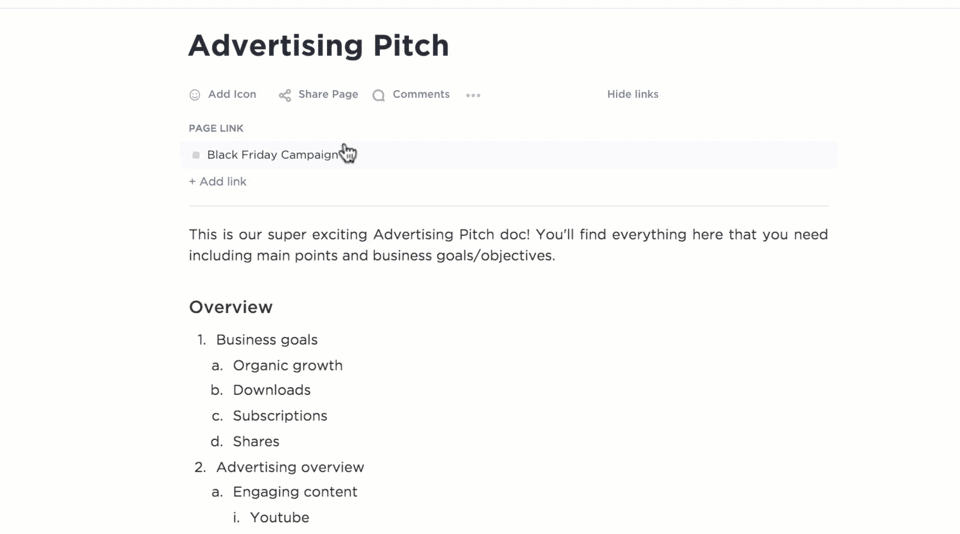
Once the category framework is in place, convert the next steps into actionable ClickUp tasks within the document, including due dates and assignees.
📮 ClickUp Insight: 16% want to run a small business as part of their portfolio, but only 7% currently do.
Fear of having to do it all on your own is one of the many reasons that often holds people back.
If you’re a solo founder, ClickUp Brain MAX acts as your business partner. Ask it to prioritize sales leads, draft outreach emails, or track inventory—while your AI agents handle the busywork.
Every task, from marketing your services to order fulfillment, can be managed via AI-powered workflows—freeing you to focus on growing your business, not just running it.
📖 Also Read: Best Free Business Value Proposition Templates
The market won’t automatically see the problem, or your solution, the way you do. Educating the market involves shaping perception, helping potential customers recognize the problem, and demonstrating why your category is the solution.
Education works at these three levels:
📌 Example: A company promoting ‘Connected work visibility platforms’ might:
ClickUp Brain’s AI Writer for Work helps you scale this education process effortlessly across every communication channel. It helps your team craft clear, consistent, and category-aligned content that informs, reframes, and persuades.
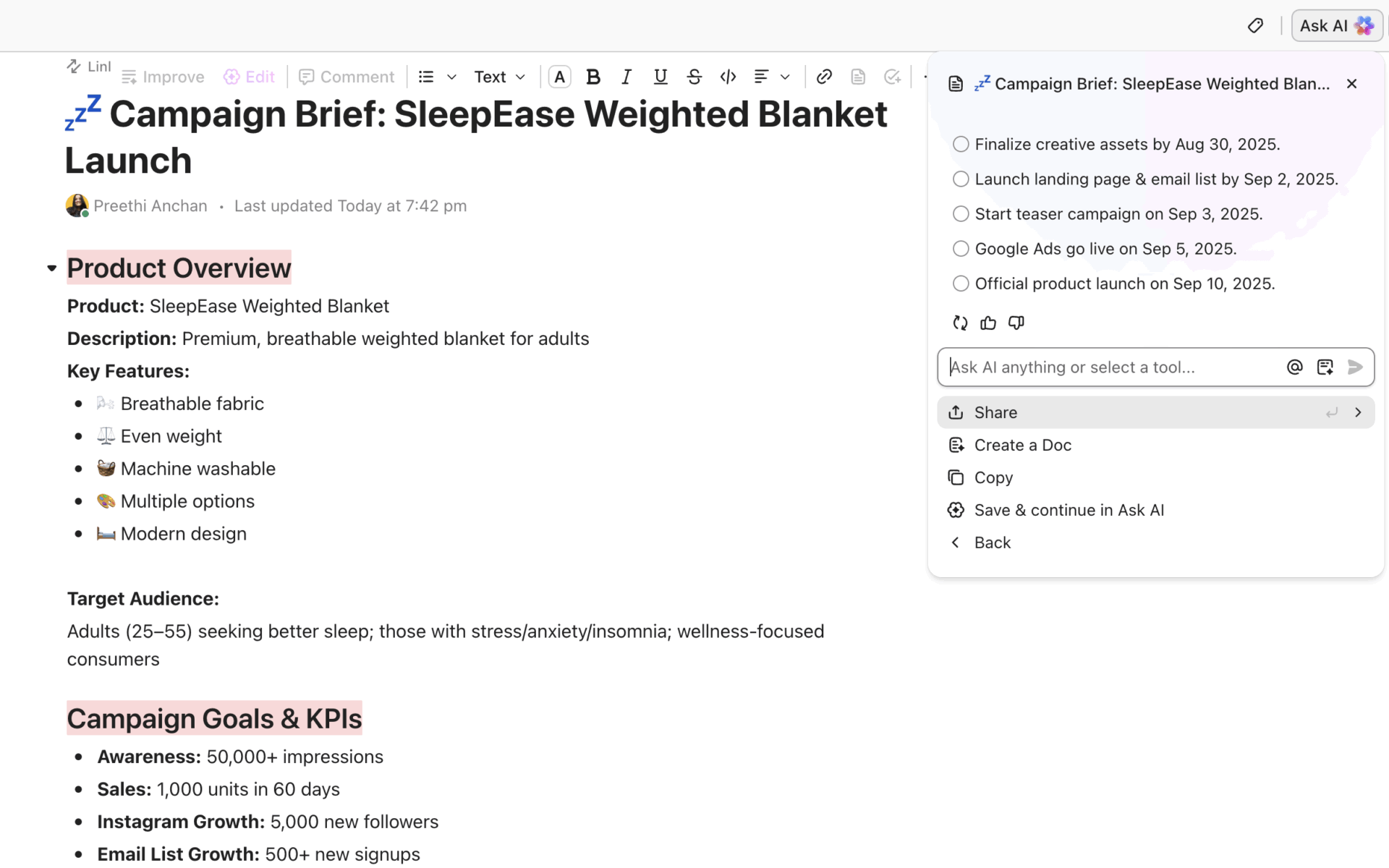
Its context-aware AI draws from your workspace data, including Tasks, Docs, and comments, to ensure every message reflects your brand voice and strategic positioning. You can create blog posts, case studies, or thought leadership pieces that spotlight the problem, explain the gap, and introduce your unique category solution.
It also ensures all marketing collateral reflects the same narrative and tone you’ve defined for your category. It draws context from your workspace to write in your company’s voice without generic AI filler. Best part? You can access multiple LLMs from Brain’s interface based on your needs!

📌 Try these prompts:
The last step is to define clear metrics that reflect both category adoption and business success.
Metrics provide measurable evidence that your efforts to educate the market, differentiate your solution, and lead the category are paying off.
Start by identifying metrics that align with the core goals of your category:
With ClickUp Tasks, you can translate high-level category objectives, like increasing market awareness or improving product adoption, into measurable outcomes. Each goal can be broken down into sub-tasks and checklist items such as search volume benchmarks, brand mentions, or customer adoption rates.
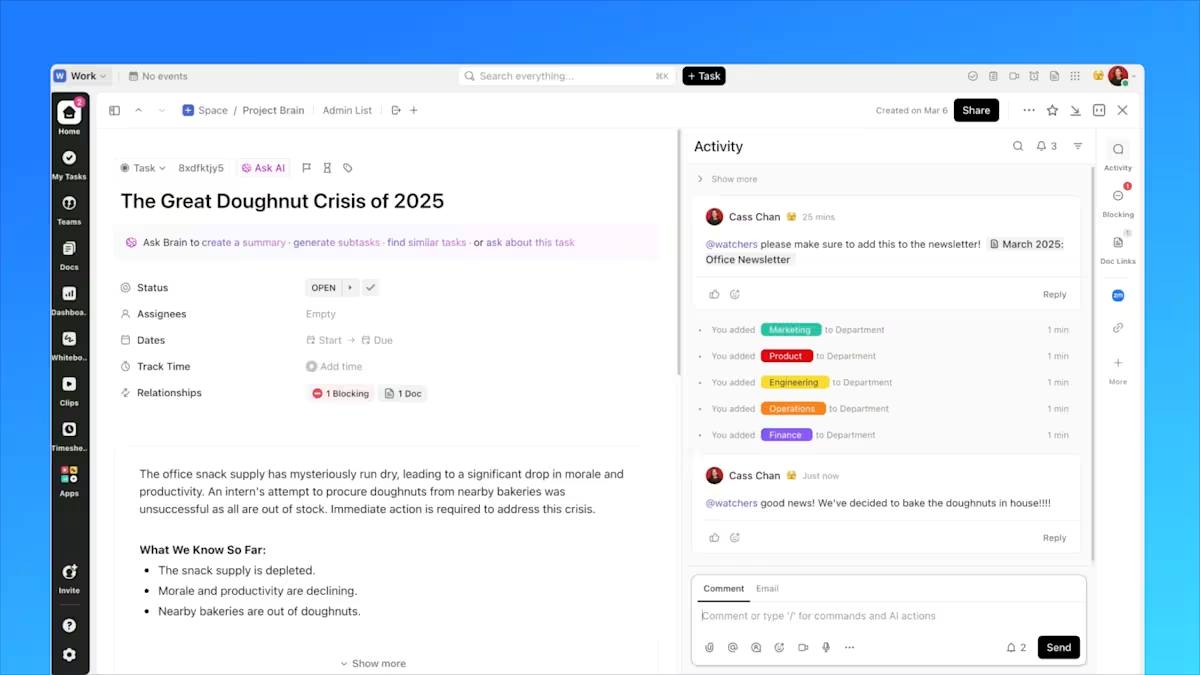
For instance, you might set a goal to ‘Increase category awareness by 30% this quarter,’ with targets tied to content reach, webinar attendance, and inbound leads.
Category creation requires company-wide alignment. Your product, business model, and company culture must all support the category vision.
Some key areas to align include:
ClickUp Chat brings product, marketing, sales, and operational teams all on the same page. You can create dedicated channels for product alignment, pricing discussions, or category campaigns.
Chat supports threads, @mentions, and file attachments, making it easy to track conversations and share relevant links or data. Additionally, you get Posts to share company-wide updates, initiatives, and important decisions. What’s more, SyncUps let you hop on a quick audio or video call for check-ins or strategic discussions.
Here’s what Chelsea Bennett has to say about using ClickUp at LuluPress:
A project management platform is essential for a marketing team, and we love that it helps us stay connected to other departments. We use ClickUp literally every day, for everything. It has been very helpful for our creative team and has made their workflow better and more efficient.
Creating a category is an ongoing process. To maintain leadership, you must continually reinforce the category’s value through consistent messaging, innovation, and proof points.
Regularly release features that strengthen the category story and solve deeper problems. You must also ensure that you share success stories, case studies, and examples that illustrate the category in action. Monitor usage, adoption, and customer insights to evolve the category positioning over time.
ClickUp Automations + AI Agents make consistency much easier to sustain. They allow you to streamline repetitive tasks, ensuring that your category messaging, updates, and social proofs are delivered on time.
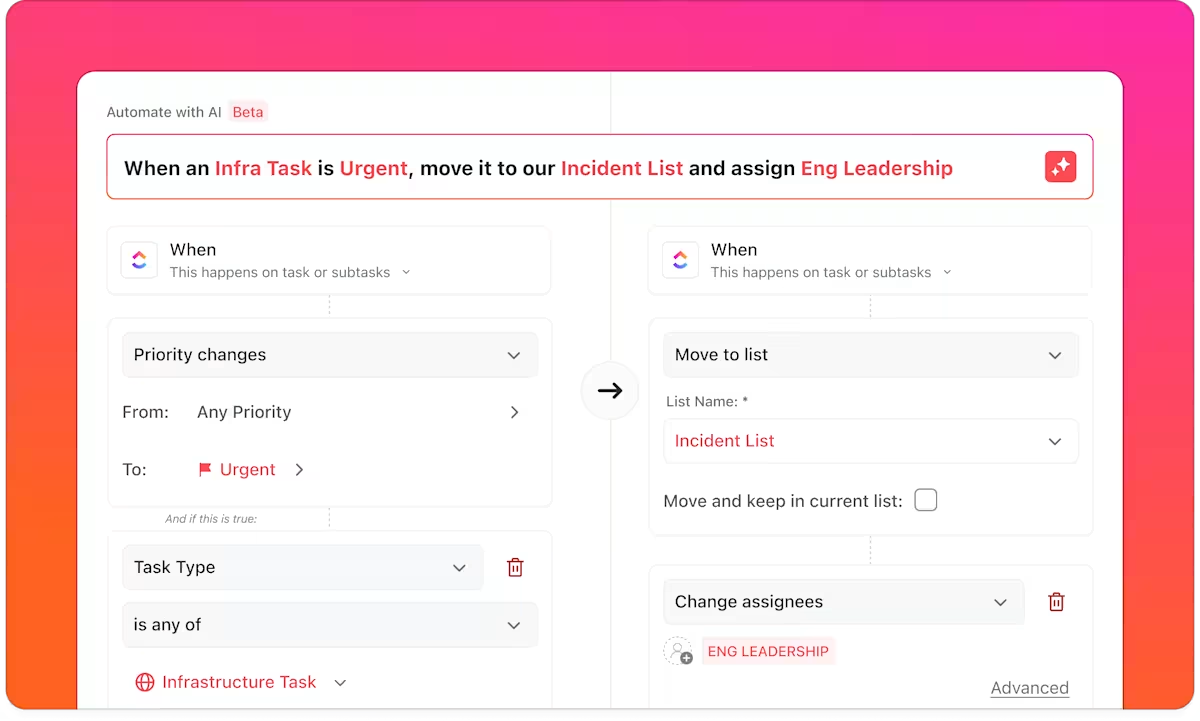
Automations work on a simple ‘when this happens, then do this’ principle. You might configure it so that when a new testimonial is added to a Doc, a Task is automatically created for the social media team to turn it into a post.
AI agents take this a step further by intelligently managing more complex workflows.
For example, beyond just creating a Task, an AI agent can draft a suggested social media post, assign it to the right team member, and even schedule it for optimal engagement. Recurring activities, such as monthly category impact reports or quarterly content campaigns, can be fully managed by AI agents—they can gather data, generate reports, assign tasks, and ensure deadlines are met, thereby reducing manual effort and streamlining your processes even further.
See one in action here:
Category design is an ongoing act of market creation, defining the problem, shaping perception, and scaling belief. To do that well, let’s look at category design frameworks for startups that can turn your idea into a category. 💪🏼
If your goal is to own your space, the Category King framework is your playbook. It’s built around one big idea: don’t sell a product, sell the problem you’re solving and the new world you’re creating.
It guides founders to craft a story around the problem they’re solving, rally early believers, and align the entire company, including product, marketing, and strategy, around that story.
Learn how to create a marketing playbook:
The Blue Ocean strategy helps you uncover or create uncontested market space; places where you can offer unique value that no one else is delivering.
Tools like the Strategy Canvas visualize what the industry focuses on, while the Four Actions Framework helps you decide what to eliminate, reduce, raise, or create to reshape customer value.
🧠 Fun Fact: Keurig created ‘single-serve coffee’ as a category. It broke away from traditional drip machines or bulk coffee makers by focusing on convenience, variety, and personal choice.
Market mapping turns abstract strategy into clear, visual insight. It helps you see where you stand, and where no one else is standing yet. You can plot existing products and competitors across variables like pricing, features, audience, or outcomes. This way, you start seeing patterns: crowded zones, neglected spaces, and opportunities.
For product managers, this process is invaluable. It shows where your product can create new value, how to position it, and which customer segments are ready for something different.
📖 Also Read: Design Thinking Process Steps & Examples
A competitive analysis helps you see not just what others offer, but how they define the game. Using tools for category creation and market mapping, like the SWOT analysis or Porter’s Five Forces, you can uncover where current narratives fall short and where unmet needs or assumptions lie.
For marketers, this becomes a goldmine. It helps refine messaging, reposition your product, and craft a narrative that reframes customer expectations.
🔍 Did You Know? Wrigley used surprising feedback to shift its business. Originally selling soap, the company noticed that people liked the free baking powder, so they included more of it. They leaned into that, switching focus to baking powder and eventually chewing gum. That pivot helped them create and dominate new market expectations.
JTBD cuts straight to the heart of why people buy a certain product or a service. It’s built around one truth: customers don’t want your product; they want to make progress in their lives.
The framework helps you find the real ‘job’ someone is hiring your product to do. A morning commuter doesn’t buy a milkshake because they love milkshakes. They buy it to fill a boring drive and keep hunger away until lunch. Suddenly, your competition isn’t Starbucks, it’s bananas, bagels, and boredom itself.
💡 Pro Tip: Interview people right after they buy, not months later. Ask ‘What were you doing when you decided you needed this?’ Their answer reveals the job. Watch for the functional job (fill me up), emotional job (make this commute less miserable), and social job (look like I have my life together). Hit all three, and you’re unstoppable.
If customers forget you exist when they need you most, this fixes that. People remember brands when specific moments trigger them, not because they saw your ad last week.
It guides you to own the moments that matter.
Map every situation where someone needs your category, then dominate the valuable ones. Be the first name they think of when it counts.
Most people who could use your category aren’t buying from anyone; they’re either suffering or using terrible workarounds. So if you only watch competitors, you’re ignoring your biggest market.
Plus, it encourages you to study why people choose nothing at all. Too expensive? Too confusing? Takes too long? Intuit found millions doing taxes with pencils. Canva found people making flyers in Word. Find who’s struggling without any solution, remove what’s blocking them, and you’ve just invented a new category.
💡 Pro Tip: Look for expensive workarounds. If someone’s paying $200/month for a VA to schedule meetings, that’s a $2 billion Calendly waiting to happen. If developers are duct-taping five tools together, that’s your wedge. The messier and more expensive their workaround, the bigger your opportunity.
Once your category is defined, the real work begins: teaching the world to see it the way you do. Dominating a new category means controlling the narrative, reinforcing your point of view, and proving that your approach represents the future.
Start by building market momentum through consistent storytelling. Your messaging, from website copy to media appearances, should echo the same belief that your category is built on.
Every campaign should connect the dots between the customer’s pain, your category’s promise, and your product’s proof. Inconsistent language is the fastest way to confuse a market. Category kings stay memorable because they repeat one clear story until it becomes market truth.
Next, turn your early adopters into evangelists. Customer stories are your most persuasive category assets. Highlight the before-and-after transformation, how your solution redefined success for them.
When others see tangible proof that your category delivers new outcomes, it validates your marketing leadership and accelerates adoption.
To sustain dominance, extend your category narrative across every touchpoint, including events, content, community, and even partnerships. Host webinars or roundtables to discuss the broader problem your category solves. Align with analysts, influencers, and media who can amplify your perspective.
When you’re mapping customer journeys, positioning competitors, or designing your go-to-market blueprint, ClickUp Whiteboards let you visualize the entire strategy in one place.
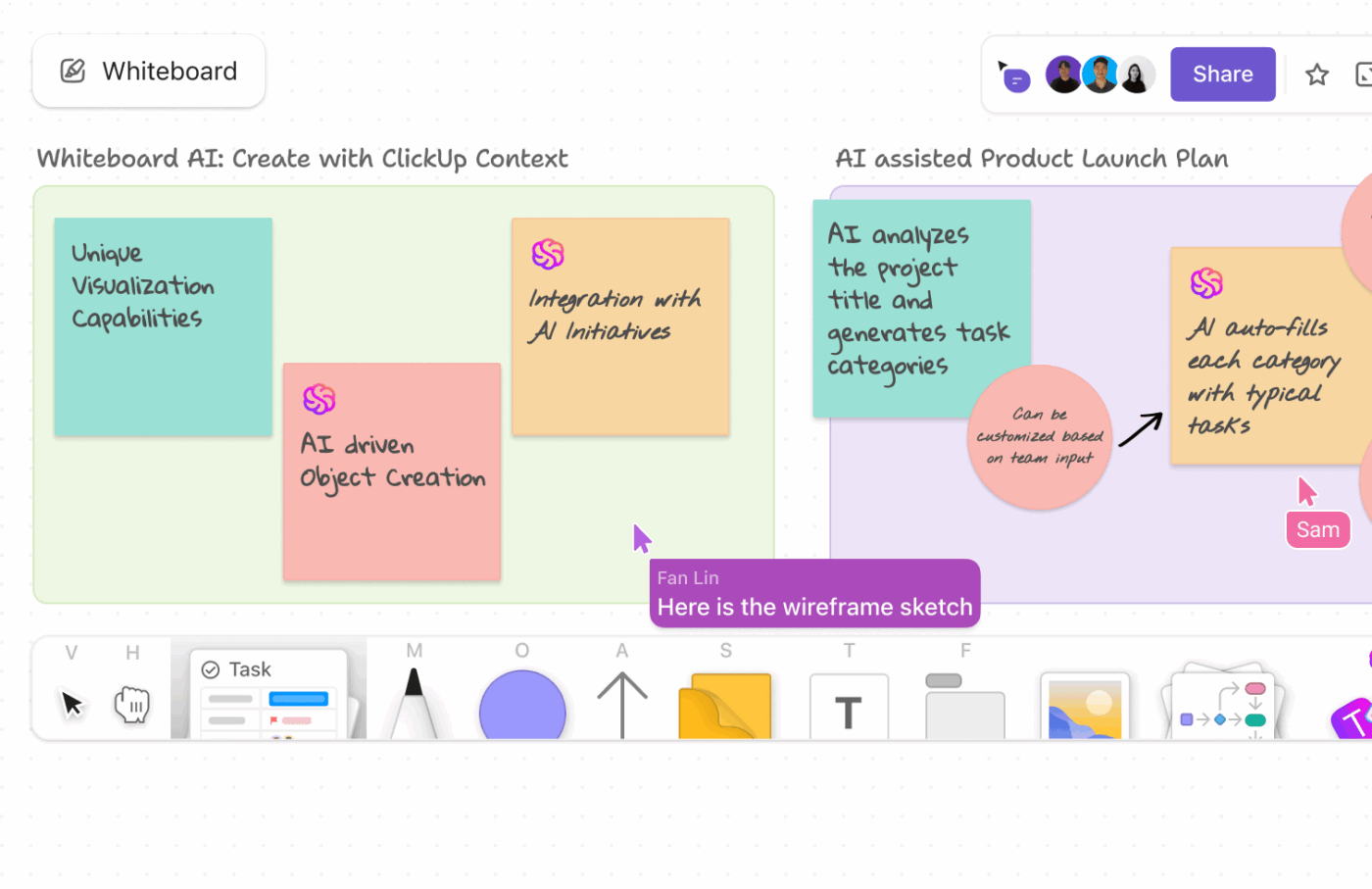
You can even brainstorm campaign ideas, define market segments, and even connect tasks and docs directly for visual marketing campaign management. For instance, your marketing team plots the Category Awareness Funnel on a Whiteboard. They link each stage, like education, engagement, and conversion, to real ClickUp Tasks with owners and due dates.
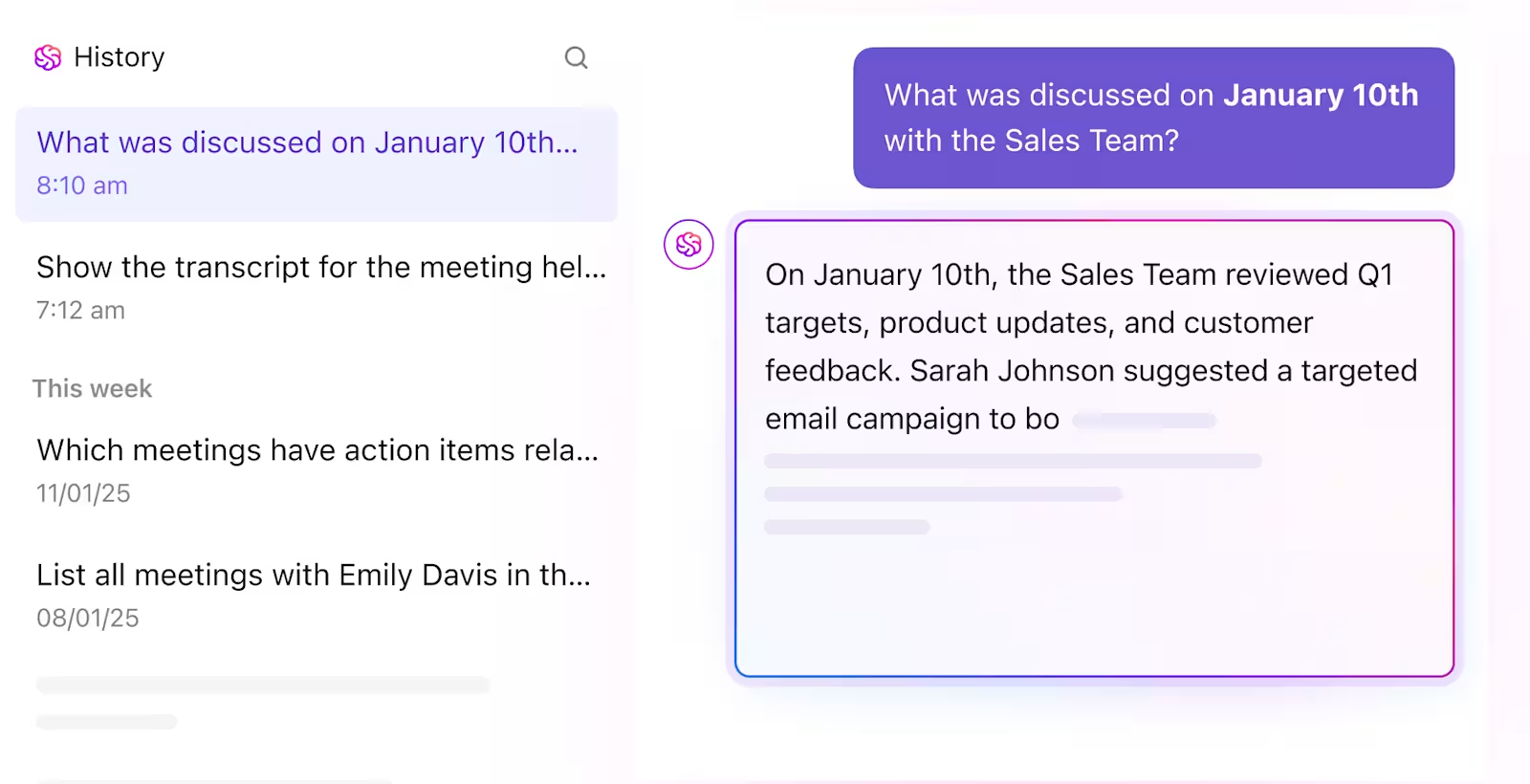
Meanwhile, ClickUp Brain acts as your category strategist and tone guardian within the strategic planning software.
The AI Project Manager automates progress tracking, stand-ups, and follow-ups. Teams can ask Brain to summarize campaign outcomes, generate project updates, or even suggest next steps based on real-time workspace data.
And when you don’t want to create a workflow from scratch? Turn to ClickUp Templates.
The ClickUp Content Calendar Template can host multiple content streams or sub-projects under one main umbrella. This way, teams can manage blogs, social media, newsletters, or other campaigns in a single location.
With four pre-configured views, including calendar, list, board, and timeline, teams can switch perspectives based on their role or task.
Your go-to market strategy template also comes with seven built-in statuses that represent different stages in the content lifecycle, such as Draft, In Review, Scheduled, and Published. Plus, five pre-configured Custom Fields enable teams to capture essential metadata, including Content Type, Campaign, Audience Segment, and Publication Channel.
🧠 Fun Fact: Category prototypes change with culture and design. What people expect a laptop or hearing aid to look like shifts, so companies that keep up with aesthetic trends in design often come out ahead.
Here, we’ll explore some common challenges in category design that you might encounter. However, rest assured, you’ll also receive input on how to overcome obstacles in creating a new market category. 👀
Introducing a new category isn’t easy. Overcoming skepticism takes patience, storytelling, and consistent education. Buyers are used to their current solutions, so convincing them to rethink the status quo can be frustrating.
Some of the key challenges include slow adoption cycles, where people simply need time to understand and embrace the category. Then there’s the resource drain: running events, creating thought leadership content, and building proof points all require significant time and investment.
📖 Also Read: Best Tools for Design Thinking
Even with a compelling category story, internal buy-in is critical, and often tricky. Teams across marketing, product, sales, and operations all have different priorities, and misalignment can stall progress.
Common hurdles include fragmented goals, where departments cling to legacy KPIs rather than pivoting to support category growth. Training gaps also emerge because leading a category often requires new skills and strategic thinking.
Leadership fatigue is another significant risk; category creation is a long-term endeavor, and executive teams that lack commitment can lose momentum.
🚀 ClickUp Advantage: Many teams struggle to translate a shared vision into content that reflects their specific role—marketing might focus on storytelling, while product emphasizes innovation. ClickUp Brain MAX helps bridge that gap.

For example, marketing and product teams could ask Brain MAX to ‘create a joint internal newsletter explaining how new features strengthen our category position,’ while sales and operations could prompt it to ‘draft a shared presentation linking customer feedback to our category goals.’
Each department contributes its perspective, and Brain MAX helps weave those inputs into cohesive, on-brand updates.
Bonus! Ask ClickUp Brain MAX to create a category design scorecard:
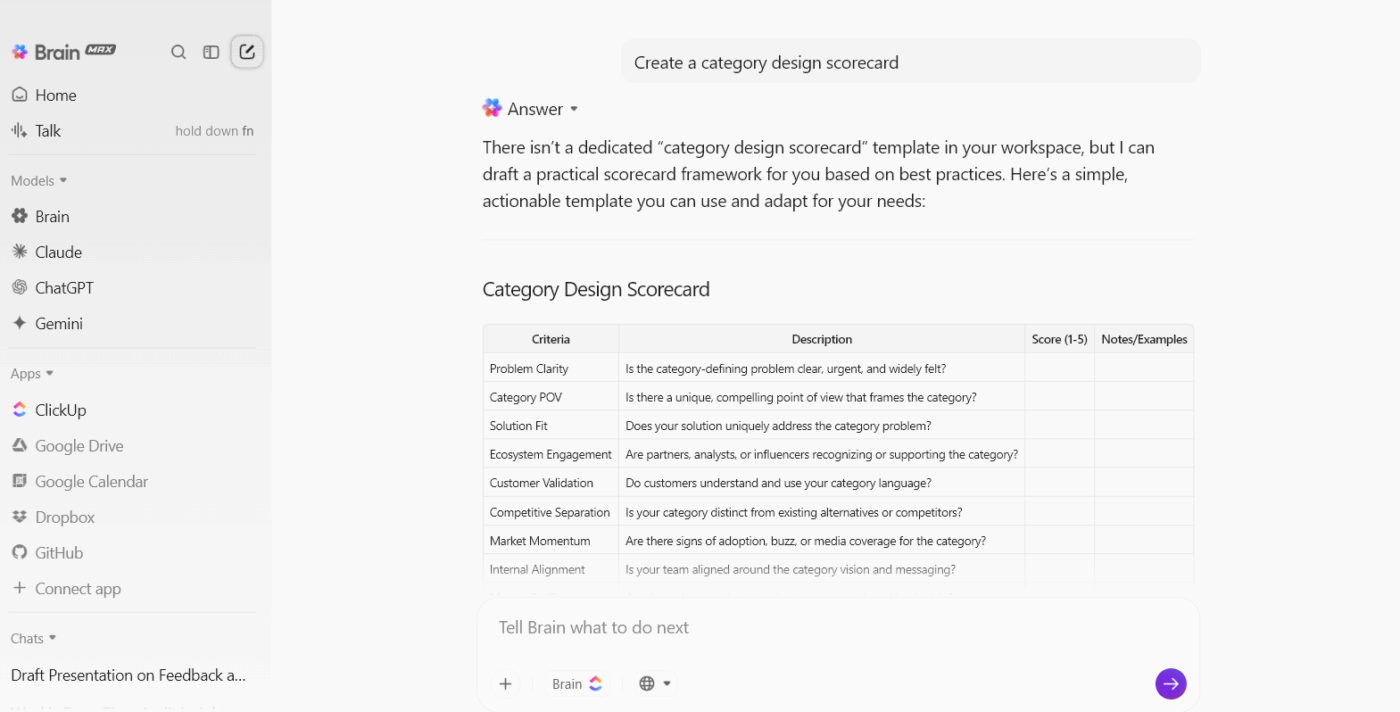
Once your category gains traction, expect competitors to fight back. Established players may copy your messaging, reshape the narrative to their advantage, or launch counter-solutions to muddy the waters.
The limitations here are clear: defending leadership against well-funded incumbents can strain budgets, especially for startups.
Short-term ROI pressure intensifies as competitors force you to demonstrate value quickly, while true category growth takes time to materialize. Fast followers can dilute your messaging, and bigger players may even try to hijack the narrative, forcing you onto the defensive.
ClickUp Brain can help with this bit:
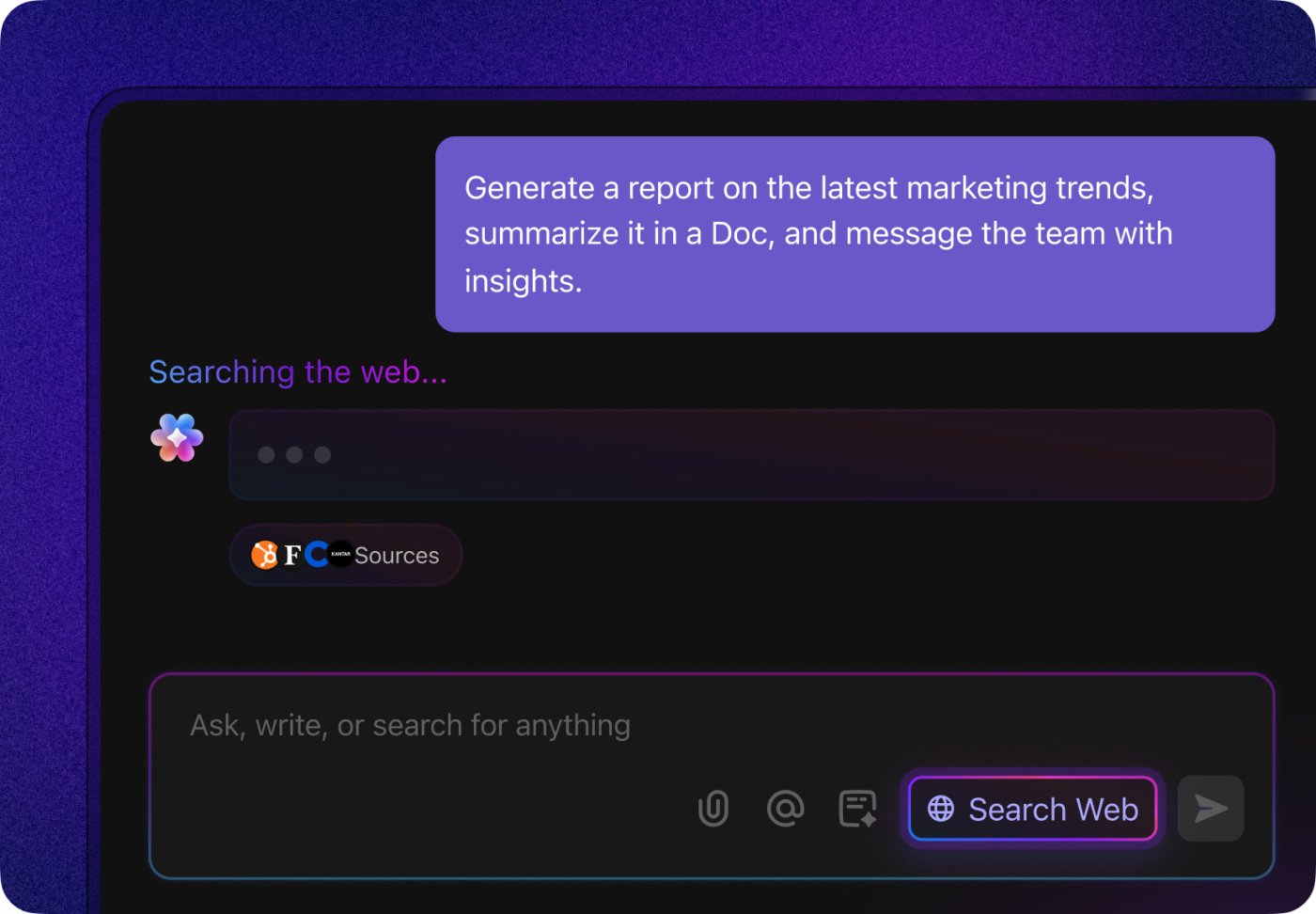
Beyond these core challenges, there are bigger-picture limitations to keep in mind. Defining a category too broadly can confuse the market, while being overly niche may slow adoption.
Investors and stakeholders may expect faster returns than a category typically delivers, testing patience. There’s also the risk of outright failure: if the category doesn’t address a real need, all investment, time, money, and resources can go to waste. Finally, missteps in initial positioning can be expensive to correct, requiring pivots, reinvestment, and messaging overhauls.
🔍 Did You Know? A paper titled “The Short History and Long Future of Research on Market Categories” shows that since the 1990s, there has been a growing stream of empirical research grouped into themes such as new category construction, category spanning, and category change.
Here are some successful market category creation case studies that have reframed problems and positioned themselves as leaders in their markets. 🎯
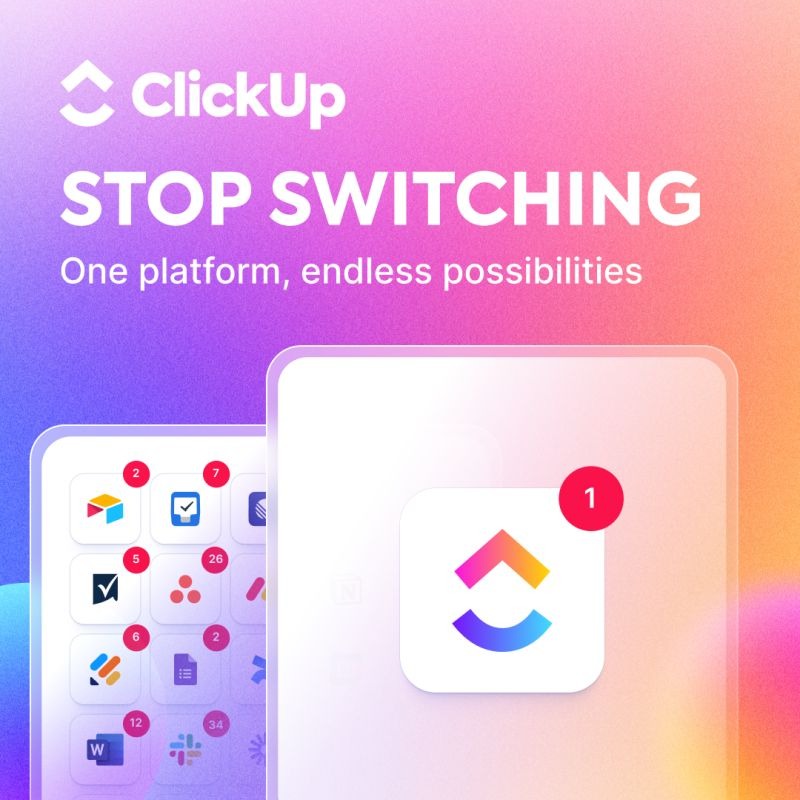
ClickUp has created a new category for all-in-one productivity, called the Converged AI Workspace. Its growth strategy combined deep user insights with content-driven education to stand out in a crowded market.
Here’s what makes it special:
💡 Pro Tip: Resist the urge to over-educate. A strong category story is simple enough that a sales rep can explain it in two sentences, and a customer can repeat it without notes. If it takes a 20-slide deck, it’s not sticky yet.

Tesla created a new standard for electric vehicles by merging automotive innovation with sustainable energy solutions. What makes this product marketing example stand out:

Netflix redefined how people consume entertainment globally. Here’s what makes it an industry leader:
📮 ClickUp Insight: 36% of respondents say they admire teammates who manage their time well and don’t seem overwhelmed.
That calm, in-control vibe doesn’t just manifest in a vacuum. It comes from intentionally designing smart systems for success. ClickUp Brain is the ambient AI productivity partner for you. It’s context-aware and understands your workload, task priorities, deadlines, and real-time calendar availability.
What does that mean in practice? The AI knows when you’re overloaded and can help auto-reschedule, reprioritize, and automate tasks via agentic workflows, allowing you to pivot quickly based on the day’s demands.

Next up in our strategic category design examples, we have GoPro. It transformed a niche camera into a global lifestyle category centered around adventure and extreme sports.
Here’s why it’s a category king:
💡 Pro Tip: Time your demand-gen carefully. If you push awareness campaigns before the category story has traction, you’ll end up educating the market for your rivals. Nail internal alignment first, then scale outward.

Spotify built a category around personalized music streaming with advanced data analytics and predictive algorithms.
What makes Spotify stand out:
🧠 Fun Fact: There was a weird period in Denmark in the 1970s: film producers were making movies that combined comedy and what used to be considered ‘illegitimate’ genre elements. To sell them, they had to reclassify or blend genres. The marketing had to help people accept something new by shifting category norms.
Category design involves rewriting the rules and showing the world a problem they didn’t even realize existed. The brands that dominate are shaping perceptions, defining new standards, and creating a movement around their solutions.
From educating the market to reinforcing your category, ClickUp, the everything app for work, centralizes every step.
You can capture user insights with Forms and turn ideas into actionable Tasks directly from Docs or Whiteboards. Align teams with Chat and SyncUps, and automate repetitive workflows with ClickUp Automations.
Sign up to ClickUp for free today! ✅
The Category Design Scorecard is a framework developed by Category Pirates to assess how effectively a company is practicing category design. It evaluates five key areas: having a clear point of view about the category, successfully defining a new category, building an ecosystem around it, using strategic language to shape how people think about the category, and leveraging data to anticipate customer needs. Each area is scored to help determine whether a company is simply competing in an existing space or actually creating and leading a new market category.
When designing a category page, it’s important to clearly communicate what makes your category unique and valuable. The page should explain the problem your category solves and how your solution is different from anything else available. Engaging content, strong visuals, and easy navigation are key, as is a clear call to action that encourages visitors to learn more, subscribe, or take another step. The aim is to make the page a central hub that educates and excites people about your new category.
Category Pirates is a group of experts in category creation and design, founded by Christopher Lochhead, Eddie Yoon, and Nicolas Cole. They provide resources, frameworks, and practical advice to help entrepreneurs and businesses create and dominate new market categories. Their work includes newsletters, books, and digital courses focused on the art and science of category design.
An example of a category in marketing is Tesla’s approach to electric vehicles. Instead of competing directly in the traditional automotive market, Tesla created and led the high-performance, luxury electric vehicle category. By doing so, they positioned themselves as the leader in a new market space, rather than just another player in an existing one.
© 2025 ClickUp